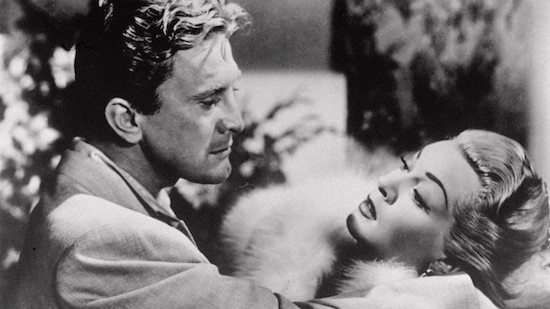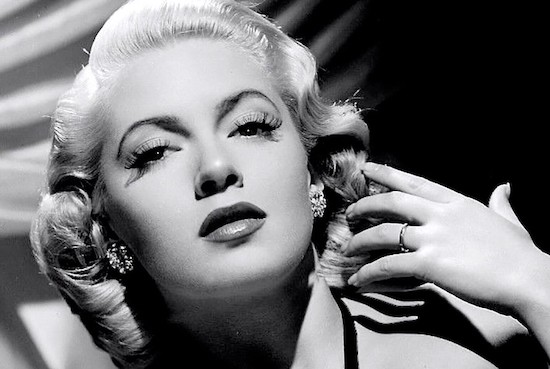Lana Turner’s first appearance on screen didn’t last very long. As the murder victim in Mervyn LeRoy’s 1937 film They Won’t Forget, she’s seen attending class, flirting with her teacher, joining a friend at a nearby soda stand, and then, at around the 15-minute mark, rushing back to school where she will meet her fate. LeRoy chose to flaunt what he would later call the young actress’ “clean sexy quality” by having Turner’s movement filmed in such a way as to show off her tightly-fitted angora top. Publicists began promoting her as “the Sweater Girl” and a Hollywood trend was born. When she died in 1995 from throat cancer – by then a screen legend, more famous for her personal life then for the roles she played – these two words would appear in the first line of her obituary in The New York Times.
Stories always found a way to follow her around. Turner would have turned 100 today, and she lives on as much in the pantheon of North American cinema’s golden age as she does in the annals of true crime. The details of her remarkable life read like a glamorous tragedy: a rough and tumble upbringing, a chance discovery, a roll call of husbands and suitors (each usually more toxic than the last), a violent crescendo, and a rise from the ashes. In the period from her breakout performance to the height of her fame in the 1950s, Turner would become synonymous with a new type of stardom—a kind of reality star long before people had learned to call it that.
She was born Judy Turner, an only child, in a small mining community in Iowa. Her father, a heavy gambler, was shot in the back after a big win when she was just eight years old. By that stage the family had relocated to San Francisco, where the young Turner moved between foster homes until her mother found them a place to live in L.A. She attended Hollywood High School, and often skipped class. She spent one of those days playing hooky, and it would change her life. The story of Turner’s discovery quickly became the stuff of Hollywood lore: she was supposedly spotted at Schwab’s drugstore by LeRoy and signed not long after. The facts weren’t quite so neat of course (she was at the Top Hat, spotted by the Hollywood Reporter founder Billy Wilkerson, and signed to the agent Zeppo Marx who recommended her to LeRoy), but it hardly mattered. A legend was born – and Hollywood always prints the legend.
She signed to MGM, where Louis B. Mayer was hoping to find a replacement for Jean Harlow (the original “Blonde Bombshell”, Harlow had died tragically that year aged just 26). Meyer began casting Turner in teen romances and musical confections – notably Ziegfried Girl – before a series of films opposite Clark Gable that would cement her as both a sex symbol and, thanks to their chemistry on screen and off, a topic of ravenous gossip. It would also make her a hugely popular pinup figure for American soldiers in Europe and Japan. By 1947, the studio had long been shifting her away from ingénue roles yet when Turner appeared in the first American adaptation of James M Cain’s The Postman Always Rings Twice, as the adulterous wife of an older man who plots to have him killed, it was nevertheless nothing short of sensational. Lana’s entrance in the film, dressed in shimmering white shorts, a crop top and heels, was about as salacious an image as you could likely see at the time. The sanctimonious Hay’s production code had been keeping American films away from sex and violence since the 1920s. Even more nefariously, the code spelled out a formula wherein any immoral character should be either punished for their improprieties or, better yet, redeemed. Audiences began getting used to seeing Lana meet such ends.
Her next great part would come in Vincent Minnelli’s The Bad and The Beautiful (1952) where she played the alcoholic daughter of a once great actor. She’s seduced by a Machiavellian movie producer, sobers up and becomes a star, but discovers that his love was a lie. The Bad and The Beautiful was one of the best of a crop of self-reflexive films from the time, stories that began to reassess the studio system and its fictions – the business was changing. Billy Wilder’s immortal Sunset Boulevard, a scathing satire about how losing the limelight could cause a person to lose their mind, had been released by MGM two years prior (Wilder cast it with washed up silent era legends and had the story narrated by a dead man). As television ownership soared (increasing from around 10% of households in 1950 to 90% ten years later), Hollywood was having its first minor existential crisis.
This began to show as much in the films being made as in the way the public began to see their stars. The production code was just one early symptom of a wider puritanical mood that would effectively sour that relationship between audiences and stars. The Red Scare of the post-war years had given way to Joseph McCarthy’s communist witch-hunts, in which Hollywood became an early and easy target. There had been gossip columns in the 1940s, but Confidential magazine, launched the same year as The Bad and The Beautiful, was the first to combine that nationalist fervor with a new kind of journalism: one that hid in the bushes and lay in the gutter. In tickling and gratifying a novel and sententious audience, it quickly captured the zeitgeist.

Turner was seldom far from Confidential’s headlines. Since her early years in showbiz, she had become notorious for having affairs with her male co-stars (including Mickey Rooney, Gable and Frank Sinatra) and in 1939, aged 19 and starring in Dancing Co-Ed, it led to a marriage with Artie Shaw. “I planned on having one husband and seven children,” she once said, “but it turned out the other way around.” Never mind Elisabeth Taylor, Turner’s was a motley crew – an increasingly lousy one – that would rival Henry VIII: first to Shaw (a band leader she would wed twice after getting pregnant, having an abortion, and attempting suicide); next a shotgun job to the actor Joseph Crane (with whom she had her daughter Cheryl); then to the wealthy son of a tin plate magnate; then to Lex Barker (one of the actors who had played Tarzan); and later the infamous hypnotist Robert Peller (who swindled her for hundreds of thousands of dollars worth of jewellery).
Barker was by far the most notorious and frightening of these men. In her memoir years later, Turner’s daughter Cheryl Crane admitted to having been repeatedly raped by her stepfather from the age of ten. When Turner became aware, she kicked him out and rebounded with Johnny Stompanato, a bodyguard of the mob boss Mickey Cohen. In 1957 she’d starred in Peyton Place (a film that, seen today, eerily resembles her life at the time) and finally received her first Oscar nomination. When she returned home from the ceremony, Stompanato, angry at having not been invited, assaulted her. About a month later, on the night of April 4 1958, she told Stompanato she was leaving him. He reacted by attacking her again, before running from the room and into Cheryl, who’d heard the shouting and had grabbed a kitchen knife. It punctured his aorta, and he died on the carpet.
Crane wasn’t charged, but the judge ordered that she be placed in the custody of her grandmother. The producer Ross Hunter, like everyone else in the city, read Turner’s story in Confidential and decided to cast her in Douglas Sirk’s soaring remake of Imitation of Life, in which Turner’s character’s daughter, played by Sandra Dee, falls in love with her mother’s boyfriend. The presciently titled film would turn out to be the commercial and artistic peak of Turner’s career. Alfred Hitchcock would consider her for Psycho the following year, before deciding on Janet Leigh. Andy Warhol did a screen print of her. She would have successes later in the 1960s, but would never reach such heights again.
What is there to be gleaned from all that life? Tennessee Williams once witheringly noted that she “couldn’t act her way out of her form fitting cashmeres.” In truth, Turner was often outshone by her costars (Gloria Grahame won the Oscar for Bad and the Beautiful despite appearing on screen for just nine minutes – Turner wasn’t nominated.) But she had the kind of quality that Susan Sontag would later celebrate “not in terms of beauty but in terms of the degree of artifice, of stylization.” That stylization would later see Turner embraced as a queer icon, on a par with Bette Davis or Judy Garland. She appeared on stage – like many of her contemporaries – in New York in the 1970s to extatic crowds of mostly gay men, still a glimmering symbol of her glimmering era but, more significantly perhaps, a survivor. Might her greatest legacy be having fabulously contributed to a culture shift, a moment when audiences began to see their movie stars as far less than celestial, and to revel in that? Or is it something more damaging? Stars were born long before Lana Turner, but how many young women heard her story and traveled out West, looking for fame but finding a lion’s den?
A lot can live on in a name. Turner was dealt more than her fair share of tragedies, yet her name seems to speak to something different from the likes of Marilyn Monroe or even Jean Harlow. Perhaps Elisabeth Grant had that in mind when, more than a decade after Lana’s death, she took her name and combined it with the Del Rey Sedan, an obscure but kind of sweet 1980s family car that Ford had produced for the Brazilian market. “It reminded us of the glamour of the seaside,” she would simply explain, “gorgeous coming off the tip of the tongue.”


